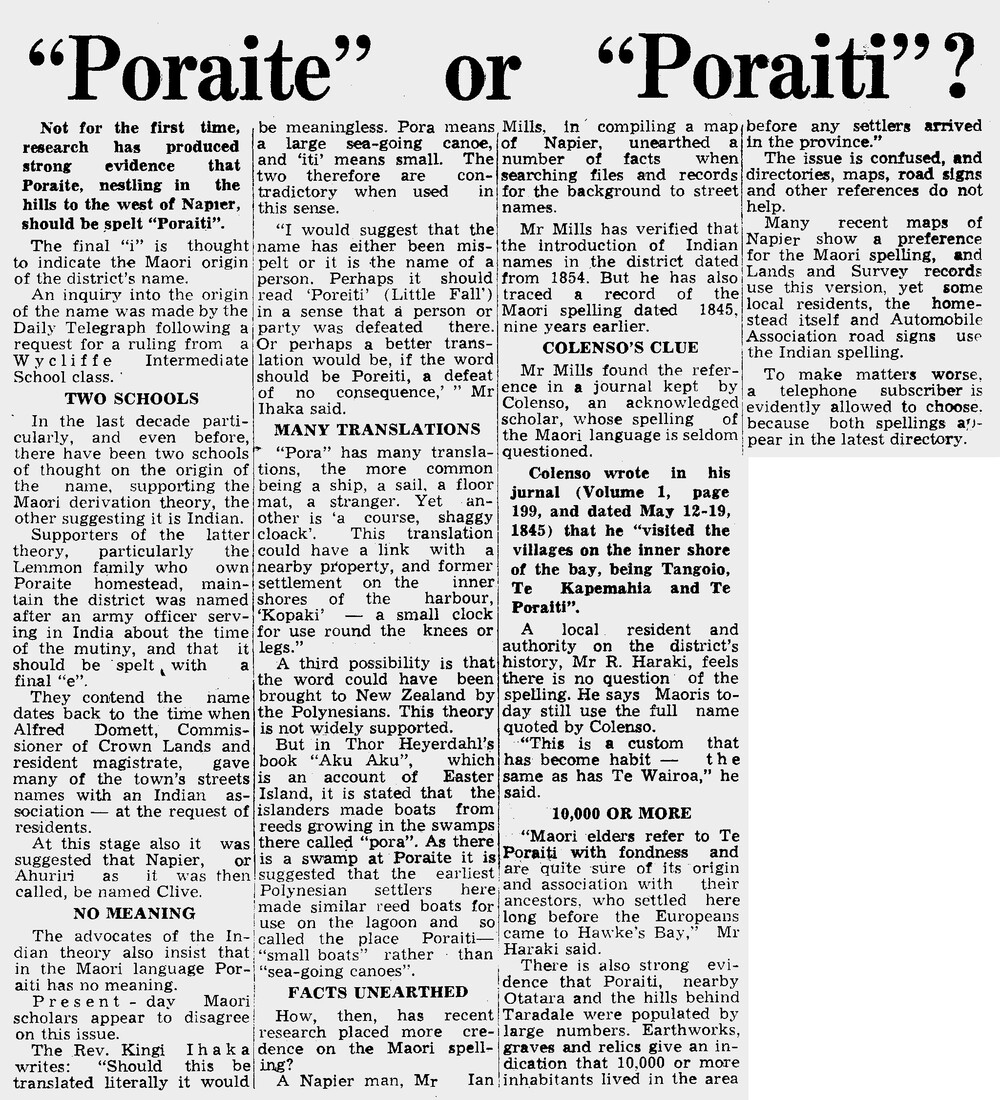“Poraite or Poraiti” ?
Not for the first time, research has produced strong evidence that Poraite, nestling in the hills to the west of Napier, should be spelt “Poraiti”.
The final “i” is thought to indicate the Maori origin of the district’s name.
An inquiry into the origin of the name was made by the Daily Telegraph following a request for a ruling from a Wycliffe Intermediate School class.
TWO SCHOOLS
In the last decade particularly, and even before, there have been two schools of thought on the origin of the name, supporting the Maori derivation theory, the other suggesting it is Indian.
Supporters of the latter theory, particularly the Lemmon family who own Poraite homestead, maintain the district was named after an army officer serving in India about the time of the mutiny, and that it should be spelt with a final “e”.
They contend the name dates back to the time when Alfred Domett, Commissioner of Crown Lands and resident magistrate, gave many of the town’s streets names with an Indian association – at the request of residents.
At this stage also it was suggested that Napier, or Ahuriri as it was then called, be named Clive.
NO MEANING
The advocates of the Indian theory also insist that in the Maori language Poraiti has no meaning.
Present-day Maori scholars appear to disagree on this issue.
The Rev. Kingi Ihaka writes: “Should this be translated literally it would be meaningless. Pora means a large sea-going canoe, and ‘iti’ means small. The two therefore are contradictory when used in this sense.
“I would suggest that the name has either been mispelt or it is the name of a person. Perhaps it should read ‘Poreiti’ (Little Fall’) in a sense that a person or party was defeated there. Or perhaps a better translation would be, if the word should be Poreiti, a defeat of no consequence,’ ” Mr Ihaka said.
MANY TRANSLATIONS
“Pora” has many translations, the more common being a ship, a sail, a floormat, a stranger. Yet another is ‘a course, shaggy cloack [cloak]’. This translation could have a link with a nearby property, and former settlement on the harbour, ‘Kopaki’ – a small clock [cloak] for use round the knees or legs.”
A third possibility is that the word could have been brought to New Zealand by the Polynesians. This theory is not widely supported.
But in Thor Heyerdahl’s book “Aku Aku”, which is an account of Easter Island, it is stated that the islanders made boats from reeds growing in the swamps there called “pora”. As there is a swamp at Poraite it is suggested that the earliest Polynesian settlers here made similar reed boats for use on the lagoon and so called the place Poraiti – “small boats” rather than “sea-going canoes”.
FACTS UNEARTHED
How, then, has recent research placed more credence on the Maori spelling?
A Napier man, Mr Ian Mills, in compiling a map of Napier, unearthed a number of facts when searching files and records for the background to street names.
Mr Mills has verified that the introduction of Indian names in the district dated from 1854. But he has also traced a record of the Maori spelling dated 1845, nine years earlier.
COLENSO’S CLUE
Mr Mills found the reference in a journal kept by Colenso, an acknowledged scholar, whose spelling of the Maori language is seldom questioned.
Colenso wrote in his journal (Volume 1, page 199, and dated May 12-19, 1845) that he “visited the villages on the inner shore of the bay, being Tangoio, Te Kapemahia and Te Poraiti”.
A local resident and authority on the district’s history, Mr R. Haraki, feels there is no question of the spelling. He says Maoris today still use the full name quoted by Colenso.
“This is a custom that has become habit – the same as has Te Wairoa,” he said.
10,000 OR MORE
“Maori elders refer to Te Poraiti with fondness and are quite sure of its origin and association with their ancestors, who settled here long before the Europeans came to Hawke’s Bay,” Mr Haraki said.
There is also strong evidence that Poraiti, nearby Otatara and the hills behind Taradale were populated by large numbers. Earthworks, graves and relics give an indication that 10,000 or more inhabitants lived in the area before any settlers arrived in the province.”
The issue is confused, and directories, maps, road signs and other references do not help.
Many recent maps of Napier show a preference for the Maori spelling, and Lands and Survey records use this version, yet some local residents, the homestead itself and Automobile Association road signs use the Indian spelling.
To make matters worse, a telephone subscriber is evidently allowed to choose, because both spellings appear in the latest directory.












Do you know something about this record?
Please note we cannot verify the accuracy of any information posted by the community.